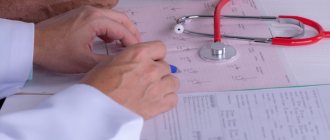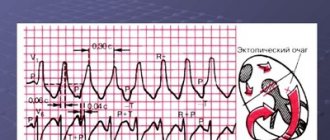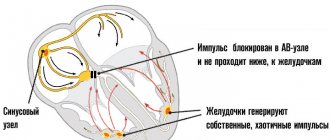general information
The term “vegetative-vascular dystonia” is currently not included in the International Classification of Diseases. Instead, the diagnosis “somatoform autonomic dysfunction of the nervous system” is used. In addition, a number of individual manifestations are classified as independent diseases. In our country, the old terminology is more often used.
The autonomic nervous system (ANS) is responsible for regulating the basic processes occurring inside the human body. Vital functions are under its control:
- breath;
- heart rate;
- tone of blood vessels and hollow organs;
- secretion of saliva, sweat, hormones;
- digestion of food;
- liver and kidney function, etc.
A person cannot control the functioning of the autonomic nervous system, which is why it is also called the autonomic nervous system. The functioning of various departments is regulated by a complex feedback system and also depends on the level of hormones. Failures in this mechanism lead to disruptions in the functioning of internal organs.
Make an appointment
Causes
Malfunctions of the ANS can be caused by various diseases and conditions. The list of the most common causes of vegetative-vascular dystonia includes:
- endocrine diseases (diabetes mellitus, hypo- or hyperfunction of the thyroid gland, etc.);
- significant hormonal changes in the body (during puberty, menopause or pregnancy);
- injuries to the brain or spinal cord (even one mild concussion can be enough to develop disruptions in the functioning of the nervous system);
- osteochondrosis of the cervical spine;
- encephalopathy of various origins;
- chronic diseases of the cardiovascular system, gastrointestinal tract;
- physical or mental fatigue;
- chronic lack of sleep;
- one-time severe stress or chronic tension of the nervous system;
- alcohol or drug abuse, smoking;
- mental illness;
- increased anxiety, hypochondria;
- use of certain medications (oral contraceptives, bronchodilators, medications based on caffeine and ephedrine);
- acute and chronic infections of the brain, kidneys, respiratory system;
- hereditary predisposition.
Changes in climate or time zones, and frequent business trips can also provoke the manifestation of VSD. Statistics show that women suffer from the disease three times more often than men. Adolescents are also at risk.
Where to look for the causes of vegetative-vascular dystonia?
First, a little dry theory: VSD is a syndrome that includes disorders of autonomic functions of various origins and manifestations, caused by a disorder of their neurogenic regulation. The term “dystonia” reflects the idea of an imbalance in the tone of the sympathetic and parasympathetic systems as a source of autonomic disorders. The reasons for its occurrence are quite diverse: - hereditary and constitutional factors.
In early childhood, hereditary burden, lack of oxygen in the fetus during pregnancy, birth injuries and diseases of infancy are important for the occurrence of VSD.
All these factors may not lead to gross organic brain damage, but lead to minimal peripheral dysfunction of the autonomic system. - psychogenic or psycho-emotional factors:
sudden, unexpected, shocking events or states of prolonged emotional overstrain leading to a nervous breakdown. The psychological atmosphere in the family is of great importance for the development of the disease (as well as for overcoming it). Let’s say, if only your mother was involved in your upbringing as a child, without your father’s active participation, then the risk of ending up in the group of people suffering from dystonia increases. As a rule, when raising a child, women often experience anxiety and doubt their competence, so they often rush to extremes, which can displease the “head of the family.” Subconscious dissatisfaction that arises in a child due to the complexity of the relationship between mother and father often causes him to feel protest, aggression, conflict and is reflected in the reaction of the autonomic system - headaches, emotional instability, short temper, and dizziness appear. Vegetative-vascular dystonia can also develop as a result of previous chronic infections, age-related endocrine changes in the body, intoxication, etc.
Symptoms
The symptoms of vegetative-vascular dystonia are varied, since the ANS is responsible for the functioning of all organs and structures of the human body. All manifestations of the disease can be divided into several groups:
- respiratory (respiratory): rapid breathing, subjective feeling of lack of air, inability to take a deep breath, aggravated by stress;
- cardiac (cardiac): frequent or rare pulse, interruptions (feeling of freezing) in the work of the heart, pain and a feeling of squeezing in the sternum or in the left half of the chest;
- thermoregulatory: an increase in temperature not associated with any infectious disease or inflammatory process; usually goes away on its own;
- dysdynamic: a sharp increase or decrease in blood pressure, accompanied by corresponding symptoms: headache, dizziness, flashing spots before the eyes, fainting, etc.;
- psychoneurological: increased sensitivity to changes in atmospheric pressure and temperature (meteosensitivity), drowsiness during the day and insomnia at night, apathy, irritability, causeless anxiety, fatigue;
- gastrointestinal: constipation, diarrhea or their alternation, pain and heaviness in the stomach, heartburn, increased gas formation in the intestines;
- sexual: decreased sexual desire, lack of arousal, inability to achieve orgasm, impotence in men.
The disease can cause both individual symptoms and various combinations of them. This makes it much more difficult to diagnose.
Symptoms of VSD in the acute stage
The cardiovascular symptom complex in VSD is manifested by the following symptoms:
- changes in heart rate;
- lability of blood pressure;
- pathological vasomotor reactions (redness, cyanosis, pallor of the skin, hot flashes, chilliness of the feet and hands).
In the acute stage, burning, stabbing, pressing, throbbing pain or discomfort in the heart area is observed.
The respiratory symptom complex is manifested by increased ventilation (rapid deep breathing), psychogenic shortness of breath (sniffling, yawning, coughing, periodic deep breaths). Hyperventilation always accompanies anxiety. Shortness of breath is accompanied by dissatisfaction with inhalation, a feeling of lack of air, intermittent breathing, and a feeling of stopping breathing. In the acute stage, muscle spasms and a crawling sensation around the mouth and in the distal limbs occur. Neurologists define Chvostek's symptom - contraction of the muscle that raises the corner of the mouth when tapped in the projection of the facial nerve. Hyperventilation may cause the following symptoms:
- headache;
- fainting state;
- pain in the heart area;
- heart rhythm disturbance;
- abdominal pain, combined with increased peristalsis, nausea, and belching of air.
The gastrointestinal symptom complex is characterized by a disorder of the functions of the digestive organs. May exhibit the following symptoms:
- disturbances of appetite, motility of the esophagus, stomach or intestines;
- psychogenic dysphagia (difficulty, discomfort during the act of swallowing or the inability to take a sip);
- vomiting;
- feeling of heaviness in the epigastrium;
- transient flatulence (bloating);
- diarrhea;
- pain in the abdominal cavity.
The thermoregulatory symptom complex is manifested by an increase or decrease in temperature, chill syndrome. The vasomotor symptom complex consists of several symptoms:
- pallor, cyanosis of the skin;
- chilliness of hands, feet;
- sensations of hot or cold flashes;
- changes in dermographism (weak mechanical irritation of the skin when carried out with a blunt object causes a trace in the form of inflamed swelling);
- increased sweating of the palms and feet.
The genitourinary complex is characterized by cystalgia (frequent, painful, imperative urination in the absence of pathology of the urinary system or changes in urine) and sexual dysfunction (impaired erection or ejaculation in men, vaginismus or anorgasmia in women with preserved or reduced libido, painful menstruation). Hormonal fluctuations, including endocrine changes in the body after childbirth, and postpartum stress provoke an exacerbation of VSD symptoms.
The neurotic symptom complex is manifested by the following symptoms:
- fatigue;
- asthenia;
- low threshold of pain sensitivity;
- sleep disorders;
- irritability;
- senestopathies (pain in the heart, a feeling of dissatisfaction with inhalation, a burning sensation in different parts of the body).
VSD occurs with a wave-like increase and decrease in the manifestations of symptom complexes. This is due to changes in etiological factors and living conditions of the patient. An exacerbation of VSD may occur in the fall. Symptoms of the disease are most pronounced during a “vegetative storm” or crisis.
Kinds
Depending on the predominant syndrome (complex of symptoms), vegetative-vascular dystonia is divided into the following types:
- hypertensive: accompanied by a short-term increase in blood pressure (within 140 mmHg), headache, rapid heartbeat;
- hypotonic: blood pressure is constantly low or decreases sporadically, which is often accompanied by severe dizziness, darkening of the eyes or fainting; patients also complain of excessive fatigue, frequent headaches and a feeling of aches throughout the body;
- cardiac: manifests itself as an increased, decreased or uneven pulse, chest pain, as well as attacks of shortness of breath, in which the patient experiences a strong feeling of lack of air;
- vagotonic: a person, first of all, complains of breathing problems: the inability to take a full breath, a feeling of tightness in the chest; the condition is accompanied by strong salivation;
- mixed: a combination of different symptoms or their alternation.
Depending on the severity, there are three types of VSD:
- mild: a person experiences symptoms rarely, they do not disrupt his lifestyle or reduce his ability to work; there are no crises;
- moderate severity: symptoms are clearly expressed and interfere with normal life activities; periodically a person may experience crises during which his ability to work decreases;
- severe: manifestations of the disease are observed almost constantly, the person cannot work normally, and is often on sick leave; vegetative crises are repeated very often.
Symptoms of vegetative-vascular dystonia
VSD syndrome can be of a constitutional nature, occurs against the background of endocrine changes, or develops with organic lesions of the central nervous system. Signs of constitutional VSD are:
- sweating;
- rapid change in skin color;
- fluctuations in heart rate and blood pressure;
- causeless rises in temperature to 39.0-37.10.
Patients do not tolerate physical and mental stress and changing weather conditions well.
The VSD syndrome, which developed during puberty against the background of endocrine dysfunction, is characterized by the following manifestations:
- vegetative-vestibular crises, which begin with dizziness and occur with a predominance of vagoinsular symptoms;
- hunger, thirst, libido;
- thermoregulation disorders, pathological paroxysmal drowsiness;
- attacks of temporal lobe epilepsy.
Hypothalamic syndrome is characterized by various combinations of autonomic, endocrine, metabolic and trophic disorders, which are caused by damage to the hypothalamus and its closest connections. Characteristic symptoms of VSD in women in the acute stage:
- ·early menopause;
- changes in the thyroid gland of hypothalamic origin;
- acromegaloid phenomena.
The electroencephalogram reveals changes that indicate the involvement of deep brain structures in the process. Damage to the hypothalamus is characterized by sleep and wakefulness disorders in the form of difficulty falling asleep, drowsiness during the day and superficial restless sleep at night.
When the connections between the hypothalamus and the temporal lobes of the brain are damaged, symptoms of temporal lobe epilepsy appear:
- aura 1–3 minutes with sensations of peristalsis, nausea, abdominal pain;
- pain in the heart area, rapid heartbeat, arrhythmia;
- labored breathing;
- increased salivation;
- involuntary chewing, swallowing;
- sweating followed by loss of consciousness and tonic-clonic convulsions.
If connections with the brain stem are affected, neurologists determine dilation of the pupils, dysfunction of the reticular formation with signs of narcolepsy, a neurological disorder in which a person loses the ability to control his own condition), cataplexy (a state of sudden loss of muscle tone while fully maintaining consciousness). Patients' sleep and wakefulness are disturbed.
The similarity of some symptoms of VSD with signs of endocrine diseases is the reason why doctors at the Yusupov Hospital conducted additional examinations. The manifestation of adrenergic crises creates the need to exclude pheochromocytoma. To exclude it, patients undergo suprarenography, pyelography, computed tomography, and scintigraphy. A urine test is performed during an attack to determine the level of catecholamines.
With VSD, there are no organic changes in all body systems; at the same time, functional disorders are determined, especially in the cardiovascular and digestive systems. Symptoms of VSD are most pronounced during an exacerbation.
Patients present the following complaints:
- weakness, fatigue, lethargy, especially in the morning;
- unpleasant sensations, discomfort or stabbing, pressing, burning, squeezing pain in the heart area of varying intensity;
- sensations of lack of air, dissatisfaction with inhalation, cough;
- anxiety, sleep disturbances, restlessness, irritability, excessive concentration of attention on the unpleasant symptoms of one’s illness;
- frequent headaches, dizziness;
- increased sweating;
- lability of blood pressure and vascular tone.
Depending on the prevailing changes in vascular tone, normotensive, hypotensive, hypertensive and mixed types of vegetative-vascular dystonia are distinguished. With the hypotonic type of VSD, signs of vascular insufficiency come to the fore. Blood pressure is below 100/60 mmHg. The patient is concerned about rapid fatigue, weakness, and a tendency to change blood pressure when moving the body from a horizontal to a vertical position. Fainting often occurs, preceded by darkening of the eyes and dizziness.
With the hypertensive type of VSD, blood pressure rises to more than 140/90 mm Hg. The leading complaints are:
- headache;
- fast fatiguability;
- rapid heartbeat, up to paroxysmal tachycardia.
In the area of the heart, areas of increased pain sensitivity are sometimes identified. Hypotonic and hypertensive types of VSD are accompanied by redness of the skin of the neck and face, coldness of the extremities, and marbling of the skin pattern.
If the patient is bothered by pain in the heart area, sometimes sharp, burning, stabbing, often poorly localized, palpitations, a feeling of interruptions in the work of the heart - this is a cardiac type of VSD.
Complications
The most common complication of VSD is vegetative crisis. This is a sudden attack during which a massive disruption of the autonomic nervous system occurs. Depending on the type of violation, there are three types of crises.
- Sympathoadrenal. Accompanied by a massive release of adrenaline into the blood, an increase in blood pressure, pulse and body temperature. The skin turns pale, hands and feet become cold and numb. The person experiences severe chills, unexplained anxiety, and fear of death. The condition is also often called a panic attack.
- Vagoinsular. The patient feels hot and suffocated, his face turns red, and severe sweating appears. Blood pressure decreases, pulse becomes rare. Often the condition is accompanied by frequent loose stools.
- Mixed. The crisis manifests itself with mixed symptoms.
If the symptoms of VSD are ignored for a long time and there is no treatment, the pathology can cause the development of:
- persistent arterial hypertension, poorly corrected by medications;
- cardiomyopathy;
- diabetes mellitus type 2;
- cholelithiasis or urolithiasis;
- stroke;
- myocardial infarction.
Excessive excitability of the autonomic nervous system also causes a decrease in immunity.
VSD has its roots... in childhood
As a rule, vegetative-vascular (also known as vegetative) dystonia makes itself felt in childhood. Children suffering from it differ from their peers: they are capricious, conflict-ridden, often get sick, and do not tolerate physical and intellectual stress well, especially at the beginning of the school year. In this case, the child may experience a constantly elevated body temperature, decreased or complete lack of appetite. Many suspicious parents begin to constantly twitch their beloved child by measuring the temperature, bring to the attention of those around him “weaknesses,” protect the child from playing sports, and “treat” him with all kinds of folk remedies. All this can lead to the development of an “inferiority complex” in a child: he is not like everyone else, it is difficult to be friends with him, he needs to be protected and spared. All this harms the child's psyche.
Diagnostics
Diagnosis of vegetative-vascular dystonia requires, first of all, the exclusion of another, more serious pathology with similar symptoms. The examination includes:
- interviewing the patient, collecting anamnesis to identify specific complaints, their strength, circumstances of occurrence, etc.; hereditary factors and previous diseases are also taken into account;
- examination: breathing and pulse rates are checked, an orthostatic test is performed (measurement of the heart rate first while lying down, and then 1-2 minutes after moving to a vertical position), dermographism is assessed (the color of the strip on the skin after holding the handle of a neurological hammer, indicating the activity of the or another part of the autonomic nervous system);
- laboratory diagnostics: general and biochemical blood tests, assessment of hormone levels, indicators of inflammation and autoimmune processes);
- ECG and ultrasound of the heart to exclude cardiac pathology;
- chest X-ray and respiratory function testing (spirometry), to exclude diseases of the respiratory system;
- rheoencephalography: assessment of the tone of cerebral vessels, the elasticity of their walls;
- Doppler ultrasound of the vessels of the neck and brain to assess the quality of blood flow in them;
- X-ray of the sella turcica, MRI of the brain to exclude tumors and other pathologies;
- electroencephalography (EEG): evaluates bioelectrical impulses in the brain and helps exclude epilepsy.
The patient must be examined by a therapist, neurologist and cardiologist. If necessary, consultations with other specialists are added, for example, a gynecologist, gastroenterologist, endocrinologist, psychiatrist.
Make an appointment
Treatment
Treatment of vegetative-vascular dystonia requires an integrated approach. The doctor is required to minimize the number of attacks, reduce their strength and duration. A combination of several techniques is used:
- drug treatment;
- acupuncture, as the most effective for stabilizing the autonomic nervous system
- physiotherapy, exercise therapy, massage;
- Spa treatment;
- psychotherapy if necessary.
Drug treatment is aimed at stabilizing the functioning of the autonomic nervous system, improving blood circulation and metabolism. Depending on the clinical situation, the following may be prescribed:
- sedatives of varying strength from herbal to prescription: improve the quality of night's rest, reduce stress and anxiety;
- antidepressants: help eliminate excessive anxiety, irritability, apathy; help stabilize the heart, reduce headaches and muscle pain;
- tranquilizers: necessary for severe panic attacks, unreasonable fears, high anxiety;
- nootropic drugs: improve metabolism and blood circulation in neurons of the brain and spinal cord, increase resistance to stress;
- adrenergic blockers and other antihypertensive drugs: used symptomatically for increased blood pressure and rapid pulse;
- B vitamins: improve the conduction of nerve impulses and have a beneficial effect on the state of the nervous system.
Physiotherapeutic techniques help improve blood circulation and oxygen supply to tissues. Some procedures, on the contrary, have a relaxing effect and increase resistance to stress. The patient is prescribed:
- laser therapy;
- magnetic therapy;
- electrophoresis;
- electrosleep, etc.
If necessary, drug treatment and physiotherapy are supplemented with a general strengthening complex of physical therapy, massage, and acupuncture. Psychotherapy is aimed at reducing general anxiety, stabilizing the condition, and working through internal blocks and fears.
Sanatorium-resort treatment is used outside the period of exacerbation. Patients are prescribed general restorative procedures: mud therapy, mineral water baths, etc. It is necessary to choose resorts in a similar climatic zone so that the trip does not cause an exacerbation of the condition.
Prevention
Preventive measures for vegetative-vascular dystonia help increase the body's resistance to stress and strengthen the immune system. They are used not only to prevent the disease, but also as an addition to the main therapy. Doctors recommend:
- normalize the work and rest schedule, prevent overtime;
- eliminate psycho-emotional irritants as much as possible, ensure a comfortable psychological atmosphere at home;
- sleep at least 8 hours every day;
- regularly walk in the fresh air (at least 1 hour a day);
- engage in amateur sports to strengthen the body: aerobic exercise (biking, race walking) and swimming have a good effect.
Proper nutrition is also important. Recommended:
- create a diet in accordance with the principles of a healthy diet with sufficient amounts of proteins, fats, carbohydrates and microelements;
- do not exceed the daily calorie intake corresponding to age, gender and lifestyle;
- drink at least 1.5-2 liters of clean water per day;
- regularly choose foods containing large amounts of magnesium and potassium (avocado, dried apricots, bananas, almonds, broccoli, peas, spinach); they help normalize the functioning of the cardiovascular system;
- minimize the consumption of black tea, coffee, spicy, fatty, smoked foods;
- exclude alcohol.
Sleep, sports and healthy food are the main protectors of the nervous system
To prevent dystonia from becoming a curse throughout life, it is best to treat it in tender childhood. For minor or rare manifestations, the following conservative but reliable methods will help: - improving your daily routine:
You need to sleep at least 8-10 hours a day, it is advisable to do gymnastics every morning and be in the air for at least 2-3 hours a day.
- playing sports in a playful, “non-standard” mode.
It is a mistake to completely exempt children with VSD syndrome from physical activity.
Such children are recommended general strengthening activities in a health group, skating, cycling, outdoor games, table tennis, and even better - swimming. - adherence to a certain diet.
It is worth limiting the consumption of table salt, fatty meats, sweets, and flour.
It is necessary to increase the intake of potassium and magnesium into the body (buckwheat, oatmeal, soybeans, beans, peas, apricots, rose hips, dried apricots, raisins, carrots, eggplants, onions, lettuce, parsley, nuts). — therapeutic massage and physiotherapy
: electrophoresis, electrosleep, water procedures, in short, everything that stimulates the nervous system.
Any hardening procedures are especially useful, because the nervous system, like our entire body, needs training to function without failure. And only in the most advanced cases, when attacks of dystonia literally poison life or seriously interfere with normal existence, is it worth resorting to drug treatment. Treatment of patients with VSD is determined only by the attending neuropathologist, taking into account the nature of the disease. As a rule, patients are prescribed anti-anxiety, sedatives, antidepressants, as well as general restoratives. Along with drug therapy, psychotherapy
, the purpose of which is to eliminate pathological symptoms. Methods of psychotherapy can be varied - this includes suggestion, hypnosis, persuasion, and the use of group classes. They are determined by a psychotherapist in each specific case. Do not hesitate to consult a doctor with such seemingly insignificant symptoms as headache, increased fatigue and irritability, excessive anxiety, etc. The sooner you start treatment, the easier it will be to cope with such an “invisible” disease as vegetative-vascular dystonia .
Treatment at the Energy of Health clinic
Doctors at the Health Energy clinic choose an integrated approach to the treatment of vegetative-vascular dystonia. After a thorough diagnosis and exclusion of other pathologies, combination therapy will be prescribed, including:
- modern medications if necessary (the choice depends on the severity of symptoms);
- physiotherapy, massage and physical therapy to strengthen the body in general and the nervous system in particular;
- acupuncture, manual therapy if indicated.
We will certainly discuss your lifestyle, tell you about ways to correct it, and help you create the right diet. Regular monitoring by our doctors will help keep the disease under control.
Advantages of the clinic
The Health Energy Clinic offers each patient the highest quality medical services at an affordable price. By contacting us, you will receive:
- consultations with experienced doctors of various profiles;
- full diagnostics to identify obvious and hidden pathologies;
- a modern and effective complex treatment scheme, selected in accordance with the characteristics of your body.
Our clinic has its own day hospital, where you can undergo various therapeutic and diagnostic procedures in accordance with the doctor’s prescription. Convenient parking and location next to the metro allows you to get to us with maximum comfort.
Vegetative-vascular dystonia can be a serious problem that interferes with a full life. Do not submit to the disease, sign up for the Energy of Health clinic.










